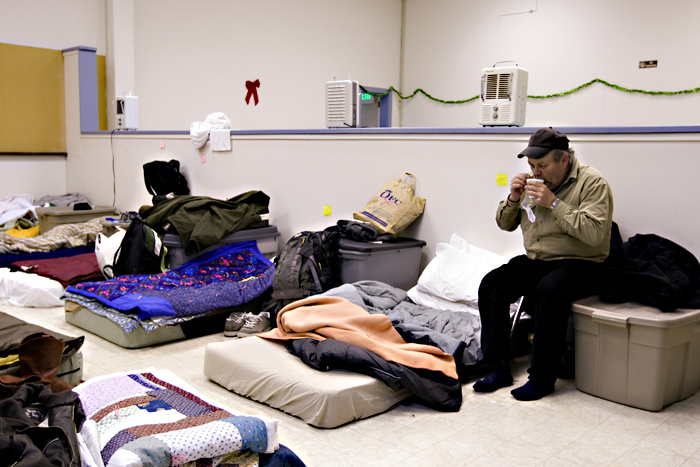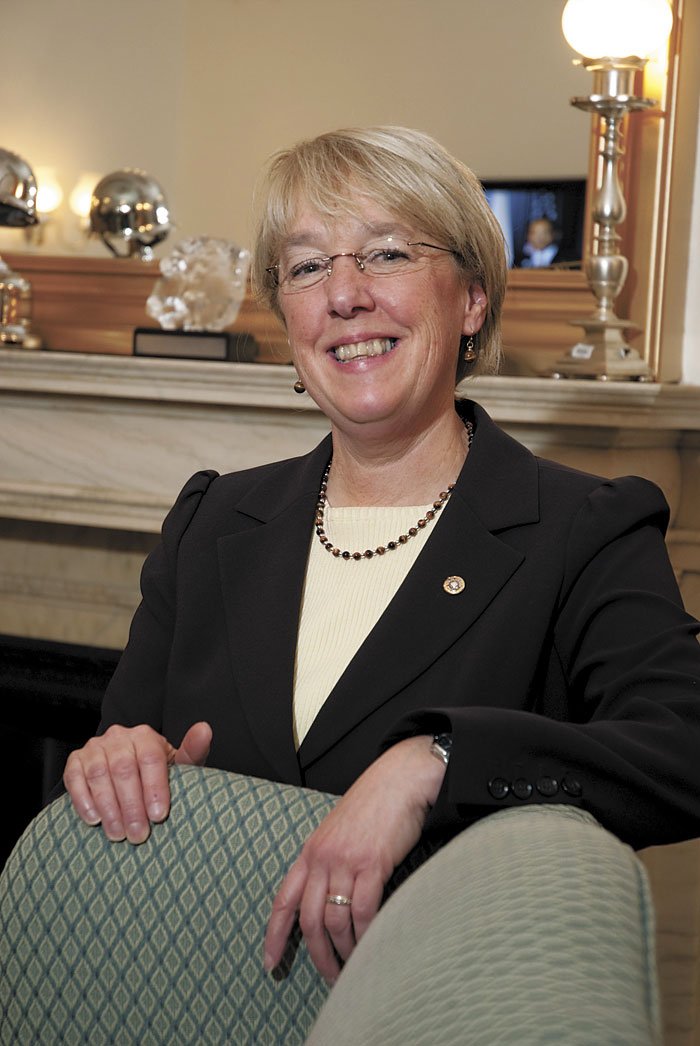The snowstorm that prompted the city to open three emergency homeless shelters has also resulted in something unusual: Anyone wanting to sleep inside can find a bed–at least until the cold snap is over.
However, weather permitting, the city will soon close the emergency shelters (still open at press time), sending hundreds of homeless people back to the streets to compete for precious few open beds.
What will remain off-limits for most, freezing temperatures or not, is the city’s newest shelter on Roy Street, which Mayor Greg Nickels opened in August. It’s the first new homeless shelter of his seven-year administration (save for occasional emergency or temporary winter facilities).
The Roy Street shelter was created specifically to house those uprooted by the sweeps—or “clean-ups,” as the mayor’s office likes to call them—after Nickels received widespread criticism this summer for kicking the homeless out of greenbelts and other encampments at a time when shelters across the city were at capacity and turning people away.
“As more people [in the greenbelts] were reached out to and accepted shelter, we needed to add more capacity. That’s why we added the Roy Street shelter,” explains Alan Painter, director of the city’s Human Services Department.
But the new shelter, which has space for 40, isn’t full. On one recent night before the deep freeze, there were five empty beds, while elsewhere around the city, shelters were turning people away. That’s because it’s available only to people who have been rounded up in the sweeps.
“When it first opened, they gave us permission to place overflow women in there on a space-available basis,” says Rev. Rick Reynolds, executive director of Operation Nightwatch, which coordinates with shelters citywide to try to match the homeless with available beds every night. “We were able to do that for about a month. Then they took that [space] away. We don’t even call anymore because it’s pointless.”
The city’s policies have had the effect of putting a high-profile population caught up in the politically sensitive sweeps ahead of those who just need temporary shelter.
“The irony is that you’re taking guys camping in the woods straight out of that and into shelter, but the average guy on the streets just trying to get by, who hasn’t become a problem to anybody yet, he’s at the end of the line,” says Reynolds. “It seems a little unfair on the face of it. If you’ve got people who want to get in, my impulse is: Let’s get them in.”
“While we commend the city for opening up new beds, we wish they weren’t so limited as to who could use them,” adds Nicole Macri, spokeswoman for the Downtown Emergency Services Center, a homeless shelter and service provider.
“The good news is that the city has seen and responded to the reality that we don’t have enough emergency shelter,” says Alison Eisinger, executive director of the Seattle/King County Coalition on Homelessness. But, she adds, “We firmly believe that the city should offer the same resources to everybody and must use every available bed every night. As a taxpayer, I want to make sure that if there are five open beds, then five people on the street get to sleep inside that night.”
Rick Friedhoff, executive director of the Compass Center, which has been contracted by the city to operate the shelter, concedes that maintaining Roy Street exclusively for those whom the city removes from the greenbelts “means some wasted capacity.”
“I don’t know if it’s exactly the way I would’ve done it. Nobody is more deserving than anybody else. All homeless people are vulnerable. You can’t tell what’s going to happen to any one of them on any given night,” Friedhoff says. “But I don’t want to throw darts at city policy. We are happy to have the new shelter.”
Unlike most shelters, Roy Street isn’t located in the heart of downtown near other services like meals, counseling, or job referral. Instead, it’s tucked into the no-man’s-land near Mercer Street between Westlake Avenue North and Aurora Avenue.
The shelter is located in a city-owned warehouse and former parks department maintenance facility surrounded by other low-slung buildings and by the family-style Italian restaurant Buca di Beppo. Initially, the location of the shelter was kept quiet so as not to alert neighbors and engender opposition.
And unlike most shelters, which often have large single rooms, Roy Street is a collection of smaller spaces with a few beds in each, something that can be good for privacy but tricky for security.
A recent visit found mats scattered in the various rooms a few feet apart, with Rubbermaid containers serving as rudimentary lockers at the foot of each. It was cold, the heat temporarily not working. Shelter organizers have been managing with space heaters and extra blankets.
Compass Center program manager Kim Sather says security hasn’t been an issue. But the lack of space to hold private conversations—or even to eat, aside from one’s bed—is. “Our biggest wish is for a common area,” she says.
Shower facilities would be nice too, though Roy Street does have ample restrooms, Sather says. The shelter opens at 8 p.m. every night and closes at 7 a.m. every morning.
While a few Roy Street residents were previously living in the Kinnear greenbelt (at the foot of Queen Anne), Sather says they’ve received no referrals from the sweep of Beacon Hill’s “Jungle” in the fall. She says most people at the shelter were formerly living under the viaduct, at the encampment under Interstate 5 on Cherry Street, or in Nickelsville—a tent city deemed illegal by the mayor and currently located in the University District.
Sather adds that roughly half the men and women living at Roy Street are the same people who initially moved in when the shelter first opened. The unusual conditions and the newness of the shelter give Roy Street the “camaraderie of a start-up,” she says.
The shelter operators would love to expand into other corners of the cavernous warehouse space. But that’s not likely to happen at this point, Painter says. “We’re in tight economic times. The city’s had to make some budget cuts. The building’s an old one. Right now we’re just making sure it’s safe.”
The city has budgeted $430,000 to operate Roy Street in 2009.
The city could still operate Roy Street as a shelter for those displaced by the sweeps and make room on a nightly basis for others in need—all it would take is a phone call.
“Systematically, we could fill these beds,” Sather says. “We could do a count and call [Operation Nightwatch] at 11 p.m.,” the time when Operation Nightwatch, which coordinates with shelters across the city, checks each night to see if there are any openings.
“They mayor’s not going to kick anyone out [of the greenbelts] after 11 p.m.,” Sather adds.
But the city has no plans to change its policy. “We don’t want to be in a position where if we have a referral there’s not space available. We would rather have consistency,” Painter says. “At this point, our goal is to have [Roy Street] as our primary shelter to support folks who are referred to outreach from encampments. That is our plan.”






